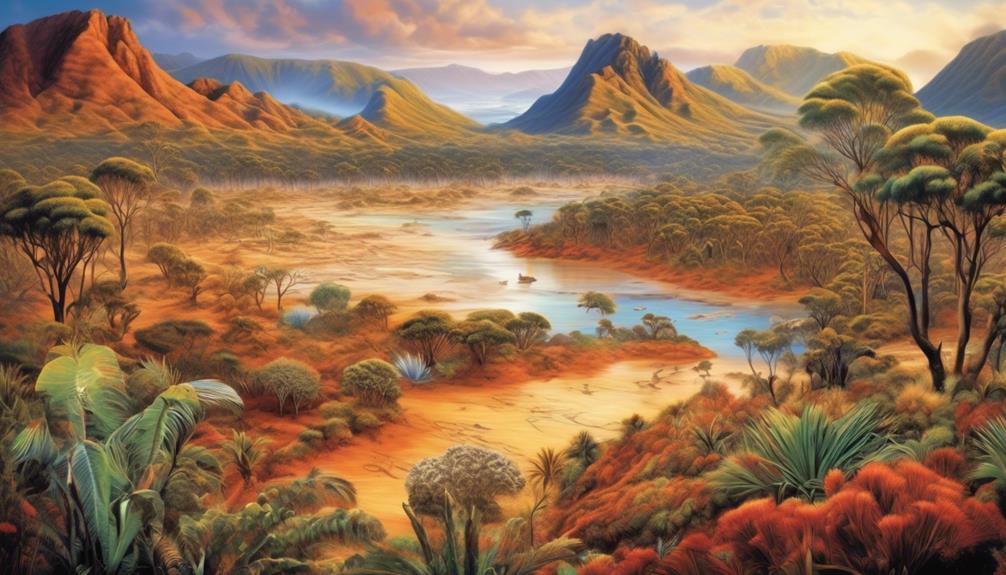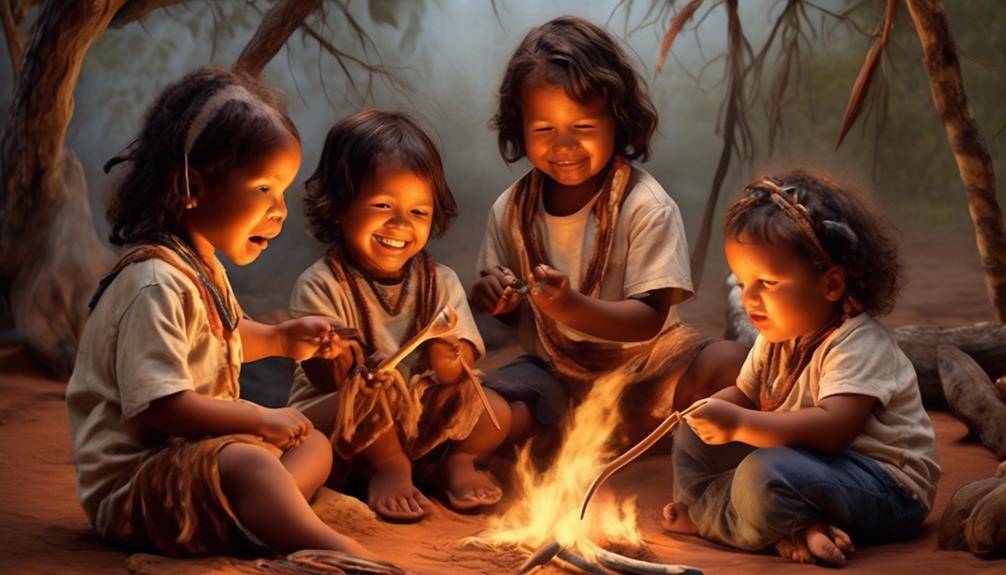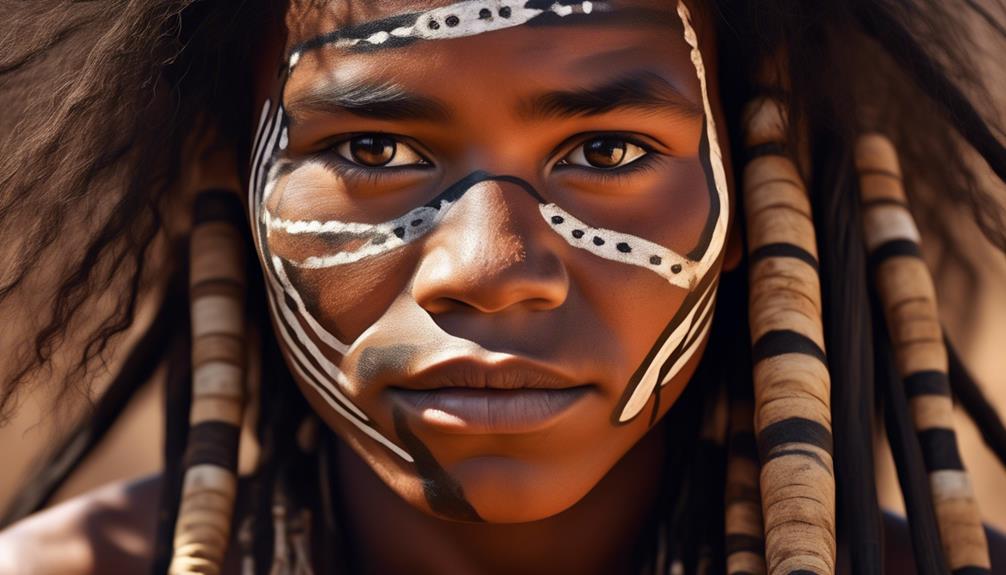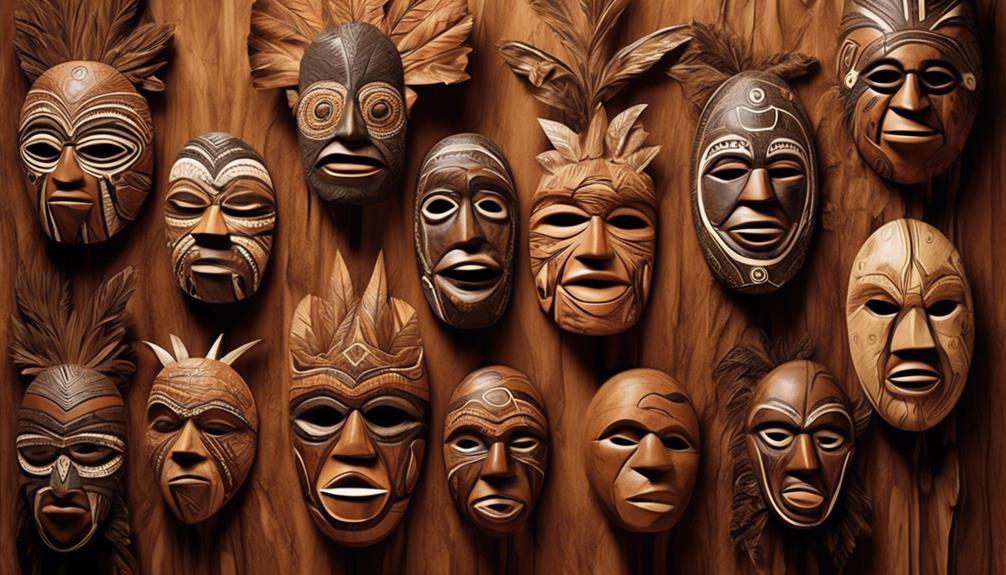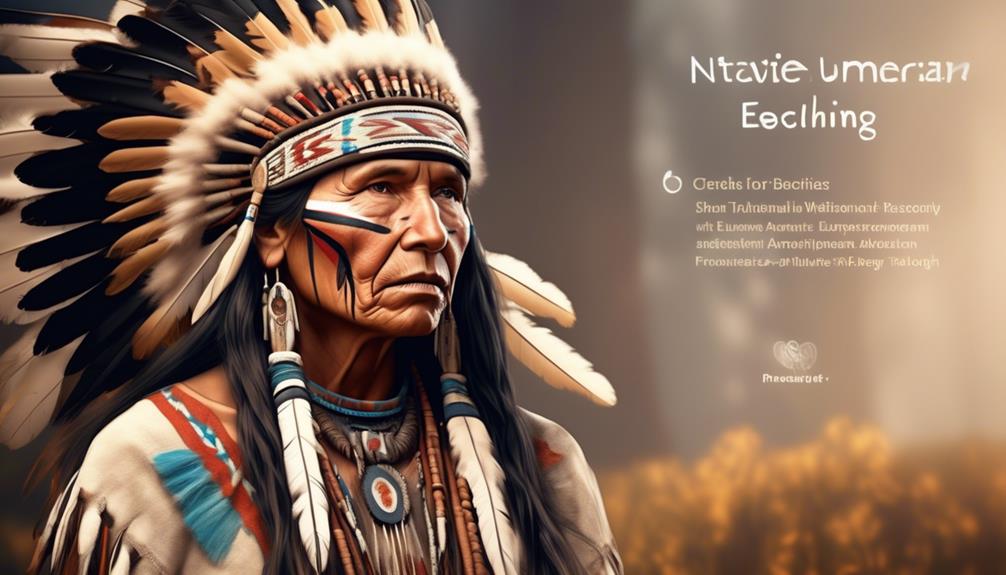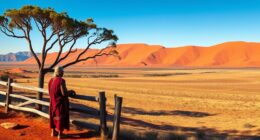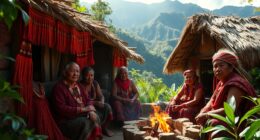In the Aboriginal cultural heritage, the concept of Dreamtime symbolizes the creation of the Earth in a deeply meaningful way. Just like how dreams blur the lines between reality and imagination, Dreamtime represents the time of cosmic beginnings when ancestral spirits shaped the land and all its inhabitants.
This belief in the Dreamtime and the Aboriginal spirit realm provides a unique perspective on the origins of the world and our place within it. But what exactly does this spiritual realm entail, and how does it shape the worldview of the Aboriginal people?
Key Takeaways
- Ancestral spirits play a significant role in the creation of the natural landscape and all living beings.
- Creation stories are passed down through generations, preserving cultural heritage and reinforcing a sense of belonging.
- The Dreamtime is a cosmic creation period that shaped the world and continues to influence the present and future of the Aboriginal people.
- Sacred sites serve as a link to the ancestors and the stories of creation, instilling a sense of responsibility for the environment.
Ancestral Spirits and Creation Stories
Ancestral spirits and creation stories play a central role in the spiritual beliefs of Aboriginal cultures, shaping their understanding of the world and their place within it.
The concept of ancestral spirits is deeply rooted in the Aboriginal cultural significance, as these spirits are believed to have created the natural landscape and all living beings. These spirits are revered and consulted for guidance, as they're seen as guardians and keepers of traditional knowledge.
Creation stories are integral to Aboriginal identity, providing a framework for understanding the origins of the world and humanity. These stories are passed down through generations, serving as a means of preserving cultural heritage and reinforcing a sense of belonging and connection to the land.
The cultural significance of ancestral spirits and creation stories can't be overstated, as they form the foundation of Aboriginal spirituality and worldview. Understanding and respecting these beliefs is essential for appreciating the rich tapestry of Aboriginal cultures and their enduring connection to the spiritual realm.
Dreamtime: The Cosmic Creation Period
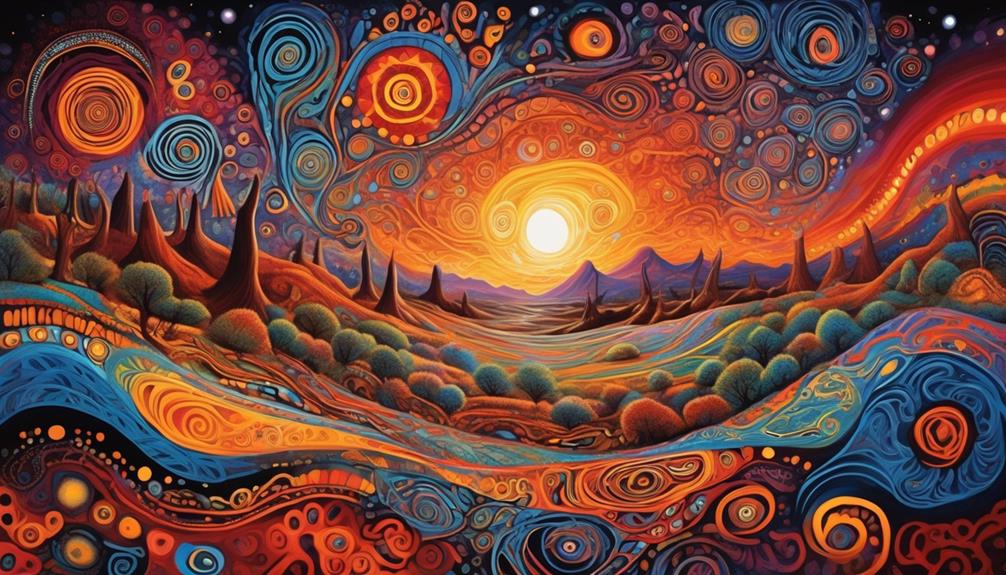
During the Dreamtime, the Aboriginal people believe in a cosmic creation period that shaped the world and all living beings. This concept is central to Aboriginal cosmic mythology and indigenous cosmology. The Dreamtime isn't just a period in the past; it's a living reality that continues to influence the present and future of the Aboriginal people.
According to their beliefs, ancestral spirits moved across the land, creating the landscape, plants, animals, and people. The Dreamtime is a time of creation, when the world was brought into existence, and the laws and moral codes for human behavior were established. It's a rich and complex period in Aboriginal cosmology, encompassing both the physical and spiritual realms.
The Dreamtime is deeply interconnected with the Aboriginal people's identity, culture, and spirituality. It provides a framework for understanding the world, their place within it, and their relationships with all living things. This cosmic creation period isn't just a myth but a foundational belief that continues to shape the Aboriginal worldview and their connection to the land.
Sacred Sites and the Land's Spirituality
The spiritual significance of the Dreamtime extends to the sacred sites and the land's spirituality, embodying the interconnectedness between the Aboriginal people and their environment. The land isn't merely a physical space for the Aboriginal people; it's imbued with profound spiritual significance and is an essential part of their cultural identity. Here's why this is so important:
- Connection to Ancestors: The sacred sites serve as a link to the ancestors and the stories of creation, fostering a deep sense of belonging and continuity with the past.
- Ceremonial Importance: These sites are central to the performance of sacred ceremonies, where rituals and traditions are passed down through generations, reinforcing the spiritual connection to the land.
- Environmental Stewardship: The concept of land's spirituality instills a sense of responsibility for the environment, promoting sustainable practices and a harmonious relationship with nature.
- Cultural Preservation: By recognizing the spiritual significance of the land, the Aboriginal people strive to protect these sacred sites, preserving their cultural heritage for future generations.
The spiritual connection to the land is a fundamental aspect of Aboriginal culture, shaping their worldview and reinforcing the enduring bond between the people and their environment.
Rituals and Ceremonies in Aboriginal Spirituality
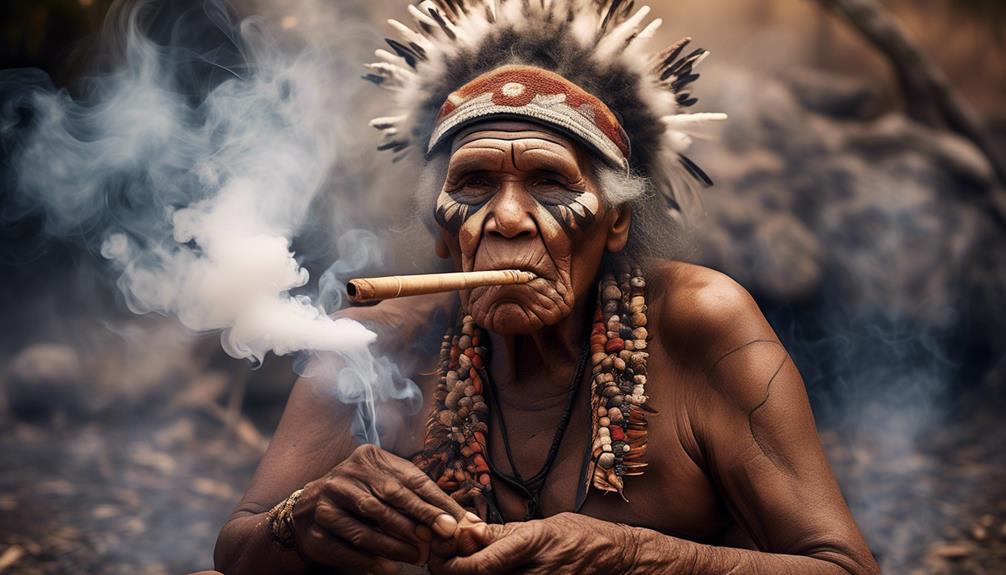
Centuries-old traditions and vibrant rituals form the cornerstone of Aboriginal spirituality, enriching their cultural tapestry with profound significance and meaning. Sacred dances and symbolic rituals are integral to the spiritual ceremonies and cultural traditions of Aboriginal communities. These rituals are deeply rooted in the belief that they maintain the balance between the physical and spiritual worlds, ensuring the well-being of their people and the land they inhabit.
Sacred dances are performed to connect with the ancestral spirits and to honor the natural elements that are revered in Aboriginal spirituality. The movements, music, and costumes in these dances carry deep symbolic meanings that reflect the stories of creation, the land, and the spirits.
Spiritual ceremonies are conducted to mark significant events such as initiations, weddings, and funerals. These ceremonies are essential for maintaining the spiritual and cultural identity of the community, passing down knowledge, and ensuring the continuity of traditions. They're often characterized by intricate rituals, storytelling, and the use of sacred objects that hold spiritual significance.
The Interconnectedness of All Living Beings
Deeply embedded within Aboriginal spirituality is the profound understanding of the interconnectedness of all living beings, reflecting a holistic worldview that transcends individual existence. This interconnectedness isn't just a concept, but a way of life that shapes the Aboriginal approach to environmental stewardship, spiritual connection, and the significance of animal totems.
Environmental Stewardship: The Aboriginal belief in interconnectedness extends to the environment, promoting a deep respect for the land, water, and all living creatures. This reverence guides their sustainable practices, emphasizing the importance of maintaining balance and harmony within nature.
Spiritual Connection: The interconnectedness of all living beings forms the basis of a deep spiritual connection that Aboriginal people share with the natural world. This connection fosters a sense of responsibility to protect and honor the Earth as a sacred entity.
Animal Totems: Aboriginal communities recognize the interconnectedness with animals, regarding them as spiritual guides and teachers. Each animal is believed to possess unique qualities that offer wisdom and guidance, strengthening the bond between humans and the natural world.
Harmony and Balance: The acknowledgment of interconnectedness underscores the Aboriginal belief in the necessity of maintaining harmony and balance within the ecosystem, emphasizing the delicate interplay between all living beings.
Frequently Asked Questions
What Is the Significance of Specific Animals or Natural Elements in Aboriginal Creation Stories and Beliefs?
In Aboriginal creation stories and beliefs, specific animals and natural elements hold great significance. They're often imbued with symbolism that reflects the cultural values and traditions of the community. These symbols are woven into ritual practices, serving as a means to connect with the spiritual realm and honor the ancestral knowledge.
Additionally, they play a crucial role in cultural exchange, fostering understanding and respect for the interconnectedness of all living beings.
How Do Aboriginal People Communicate With Ancestral Spirits and Seek Their Guidance in Daily Life?
We often maintain our ancestral connection through various spiritual practices. Traditional rituals play a significant role in our cultural heritage, serving as a means to communicate with ancestral spirits and seek their guidance in daily life.
These practices are deeply rooted in our belief system, fostering a strong connection with our ancestors and providing a sense of continuity and wisdom that guides us through life's challenges.
Can Non-Indigenous Individuals Participate in or Observe Aboriginal Rituals and Ceremonies?
Yes, non-indigenous individuals can participate in or observe Aboriginal rituals and ceremonies with cultural sensitivity. Participation should be approached respectfully, honoring indigenous perspectives.
Observing ceremonies requires understanding and respecting the significance behind them. It's important to seek permission and guidance from the Aboriginal community, as each ceremony carries unique cultural and spiritual significance.
This approach fosters mutual understanding and appreciation, creating opportunities for meaningful cross-cultural exchange.
How Do Aboriginal Communities Address Environmental Conservation and Protection of Sacred Sites in Modern Times?
In today's world, community engagement is pivotal for environmental conservation and protection of sacred sites. Aboriginal communities use traditional knowledge to inform sustainable development, preserving their culture and managing the land.
This approach fosters a deep spiritual connection to the environment, ensuring the preservation of sacred spaces. By integrating cultural practices with modern strategies, they uphold their heritage while safeguarding the earth for future generations.
Are There Specific Guidelines or Protocols for Non-Indigenous Individuals to Follow When Visiting Sacred Aboriginal Sites?
When visiting sacred Aboriginal sites, it's crucial to approach with respectful behavior and cultural sensitivity. Non-indigenous individuals should be mindful of the significance of these sites and seek to understand and follow any specific guidelines or protocols set by the local Aboriginal community.
Respect for the cultural and spiritual importance of these places is paramount, and visitors should strive to engage with reverence and appreciation for the traditions and beliefs of the Aboriginal people.
Conclusion
In the vast expanse of the Australian outback, the ancient spirit realm of the Aboriginal people pulses with the rhythm of creation. Their ancestral spirits and Dreamtime stories weave a tapestry of interconnectedness, where the land and all living beings are intertwined in a sacred dance.
Through rituals and ceremonies, they honor the spirituality of the land and celebrate the timeless wisdom of their ancestors. In the heart of the Aboriginal spirit realm, the world is alive with the echoes of creation.

